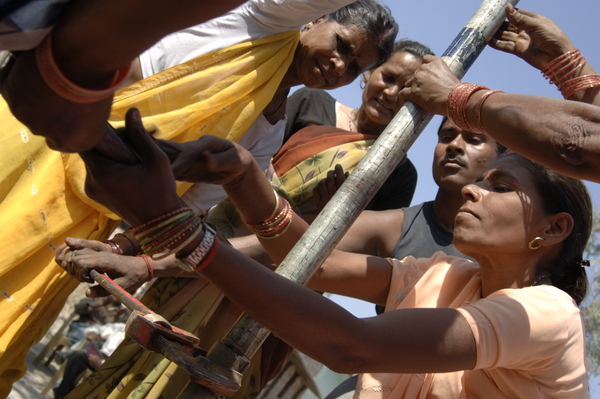After a Hundred Years of International Women’s Day, Time to Get Back to Basics
|

Women in Uttar Pradesh, India, receiving pump maintenance training from WaterAid's local partner Gramonati Sansthan. Photo credit: WaterAid / Marco Betti
While I've been working on international women's rights for years, I am new to looking at them through the lens of water and sanitation. Yet, as we mark the 100th International Women's Day this week, it is incredibly clear that much of the progress we seek for women cannot be achieved without greater attention to water, sanitation and hygiene (WASH), a basic building block of health and development.
Worldwide, nearly 900 million people live without safe drinking water, while 2.6 billion lack improved sanitation. The lives of many, especially women and girls, are dictated by their absence. So, this year, perhaps it's time to get back to basics, and recognize how lack of WASH and resulting diarrheal disease defy the principles of International Women's Day.
Women in rural Africa spend 26% of their time collecting water, walking miles a day, carrying heavy loads that can cause physical injury, risking sexual assault while alone in isolated areas. Time that could be better spent growing food, working or caring for their families.
After all this effort, the water they collect is frequently unsafe to drink. This, along with poor hygiene and lack of sanitation that contaminates water sources, leads to diarrheal diseases that kill 4,000 children a day and make millions more miss school (lack of latrines at schools can also cause menstruating girls to stay home).
Lack of WASH services contributes directly to poverty, disease, and violence, all of which disproportionately impact women (70% of the world's poor are women). So, some brief observations, from a new member of the WASH community, about how we can contribute to the global movement for women and girls:
Remember that WASH is foundational to other global health and international development objectives. Tell stories about how lack of safe drinking water and improved sanitation can compromise the success of health, education and poverty reduction programs. Identify as a women's health issue and partner with others who do the same. Get a seat at the table.
Focus on equity and inclusion. Are we reaching the people who most need services, such as people living in urban slums, the disabled and people living with HIV/AIDS?
Include women in program implementation and advocacy. At WaterAid, we always include local women when planning projects. This helps ensure wells and latrines are sited where it makes most sense for people using them, that behavior change efforts work for the community, and that people are dictating improvements in their own lives.
Don't back down. We must address the most basic needs in order to lay the foundation for improvements elsewhere. By reducing the impact of unsafe drinking water and poor sanitation and hygiene, we can help ensure that women and girls can look ahead with dignity to a healthier, more prosperous future.
-- Lisa Schechtman, Head of Policy & Advocacy, WaterAid in America














